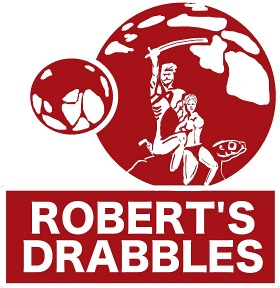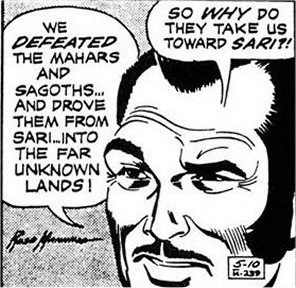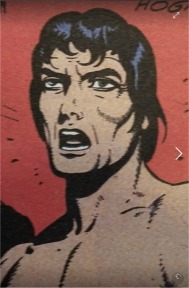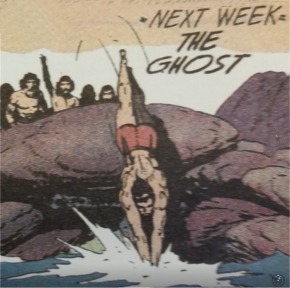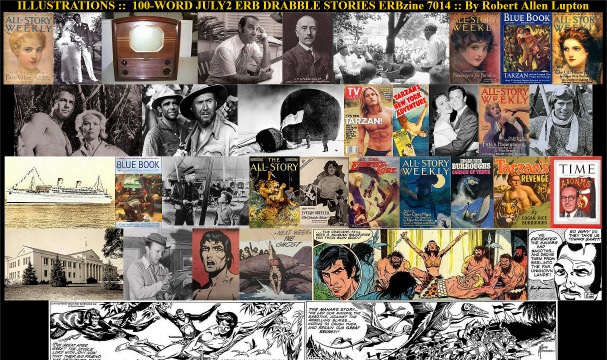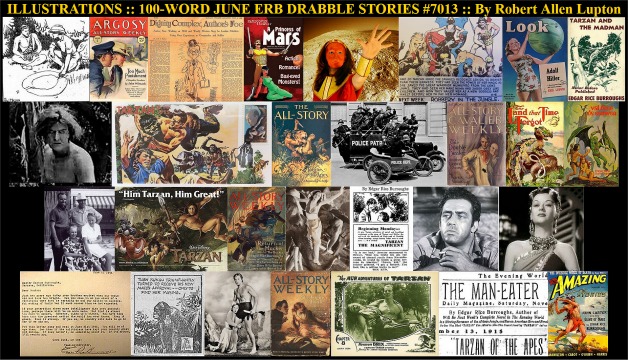WHAT HAPPENS ONBOARD
July 16, 1940: Edgar Rice Burroughs
began writing the short story, “The Strange Adventure of Mr. Dinwiddie.”
He finished the 5700 word story the next day. The story takes place on
an ocean liner, and was no doubt based on Ed’s recent trip to Hawaii. He
arrived there on April 29, 1940 on board the S. S. Monterey.
The story was marketed unsuccessfully under the non-de-plume,
John
Tyler McColloch, and remained unpublished until it was included in
the 2001 Adkins and Guidry publication, “Forgotten
Tales of Love and Murder". As far as I can tell, this is the only
publication of this story of intrigue, seduction, and murder.
Dinwiddie County Virginia is the site of several Civil
War battles including the battle of Dinwiddie Courthouse. It’s not too
much of a stretch to think that ERB learned about these battles while in
military school. Dinwiddie is the kind of name a man remembers, besides,
it’s fun to say. The photograph is of the S S. Monterey.
“What Happens Onboard” is the drabble for today.
The purser checked his roster and ordered a porter
to carry Mr. Dinwiddie’s luggage to his stateroom. “Please stay on board,
we depart shortly.”
“This is my first trip. Is the voyage dangerous?”
“Not when the Captain does it right, but the trip can
be fun. Mingle with the other guests. Friends are made. New loves are found
and old loves are lost. Fortunes are won and lost in the gaming room. Shipboard
romances are fleeting and soon forgotten.”
“I shouldn’t care to damage my reputation.”
“Enjoy yourself. The sea is silent. Remember the saying,
“Dead men tell no tales.”
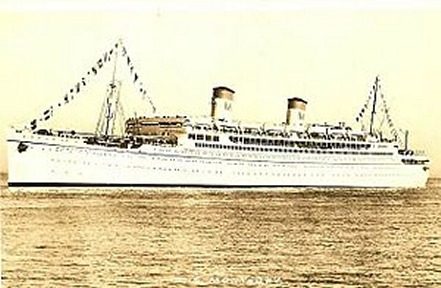
GLASS JAW
July 17, 1939: Edgar Rice Burroughs
began writing “Tarzan and the Champion,” included as the second
story in “Tarzan and
the Castaways,” published by Canaveral Press in December of 1964.
400 copies were released in December with 1965 printed on the copyright
and title pages. Distribution was halted until January 2, 1965 when stickers
were produced to correct the publication date to 1964. So copies released
in 1964 have a 1965 date, while copies released in 1965 have a 1964 sticker.
My copy of the book does not have a sticker on the title
page, but has a sticker listing copyright dates for each of the three stories
and for “Tarzan and the Castaways” on the copyright page. A photo of the
sticker is attached.
Blue Book paid $250 for “Tarzan and the Champion’ and
published the story in April, 1940. The story received a short blurb on
the cover. The cover illustration by Herbert Morton Stoops is for “Warlock
Finn” by H. Bedford Jones. (I think.)
“Glass Jaw” is today’s drabble.
One Punch Mullargan was the dirtiest fighter to ever
be heavyweight champion. After defending his title, he went on safari in
Africa. He was as dirty a hunter as he was a fighter. He hunted with a
machine gun and killed indiscriminately.
Tarzan ordered him and his guide, Melton, to leave
Africa.
Mullargan squared off to fight. “No man orders One
Punch Mullargan around.”
Tarzan dodged three quick jabs and knocked out the
champ with a single uppercut. “I don’t understand. Does his name mean he
knocks men out with one punch or that he can’t even take one punch?”
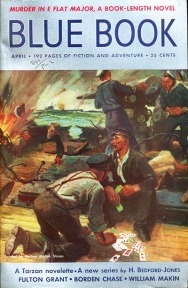
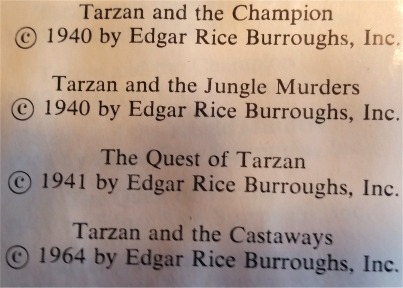
TALK TO THE ANIMALS
July 18, 1902, the actor Theodore Childress
“Chill”
Wills was born in Seagoville, Texas. Wills played Manchester Montfort,
an animal trainer, in “Tarzan’s
New York Adventure” and had a role in “End of a Challenge,” an
episode of Ron Ely’s Tarzan. He played Richard Montrose. Here’s a picture
of young and skinny Mr. Wills with young Johnny Sheffield.
“Talk to the Animals” is the drabble for this date.
Boy asked, “What’s your job, Mr. Montfort.”
“I train the animals to do tricks. What’s your name
and why don’t you have any clothes”
“Name’s Boy. These are my clothes.”
“I know you’re a boy, even with that long hair, but
what’s your name?”
“Boy.”
“You have to have a name. Even animals got names.”
“You have four lions named Ka-Ba-La, Oom-Pa-Pa, Sham-Ba-La,
and Koom-Ba-Ya.”
“No, little boy, their names are King, Queenie, Prince,
and Pirate.”
“To you, but not to them. They told me their names.”
“They talk to you?”
“They speak to everyone, but most people don’t listen.”
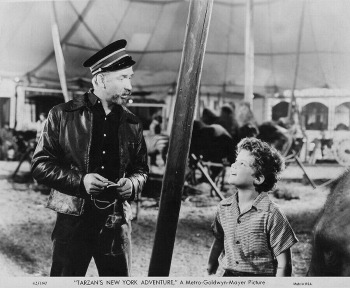
TUSKER, THE SUN GOD
July 19, 1981: The
Mike Grell Sunday Tarzan strip, “Return
to Opar” began. It ran for a ten weeks. Mike is probably best remembered
for his DC comic, The Warlord, but he also contributed artwork to Aquaman,
Batman, Phantom Stranger, and Green Lantern/Green Arrow. It would be difficult
to list all of his work and I won’t try, but I will say that I have always
admired his work.
He wrote and drew the Tarzan Sunday strip from July 19,
1981 until February 27, 1983 except for Sunday, February 13, 1983. Thomas
Yeates drew that one.
“Tusker, the Sun God” is the drabble of the day.
Jessica Faraday, a photographer hired Tusker Shanks
to guide her through Africa. Things went badly and the two ended up in
Opar. Tarzan intervened before the La and the Oparians sacrificed the couple
to the Sun God.
Tusker refused rescue. He believed La would make him
a god in the golden city. Tarzan tried to explain that Oparians believe
human sacrifice makes a man one with the Sun God.
Tusker placed himself on the altar. “You’re jealous
she didn’t choose you.”
Jessica asked, “What will happen to him.”
“Today, La will make him a god – a god without a heart.”
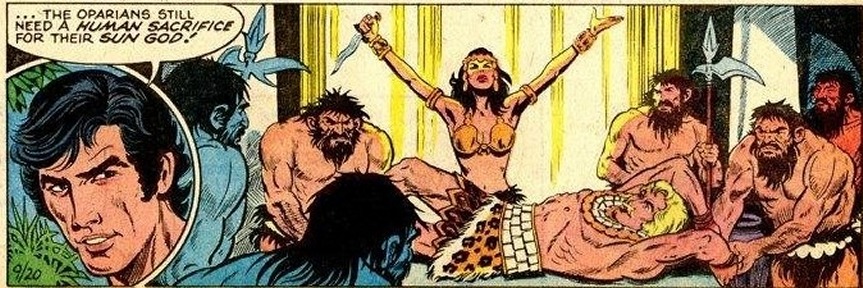
TRASH OR TREASURE
July 20, 1912: The first published
image of Tarzan appeared, when the issue of All-Story
Magazine dated October 1912 hit the newsstands with a cover image
by Walter Clinton Pettee,
who was born on this day in Birmingham, Connecticut on July 20, 1872. Happy
Birthday, Clinton. He drew several other All-Story covers including “The
Cave Girl,” and numerous covers for Argosy Scientific American, and Motor
Age. He illustrated George Allan England’s novel, “Darkness and Dawn.”
Trash or Treasure” is today’s drabble.
“Clinton Pettee’s wife, Alice, read him a letter from
Bob Davis at Munsey’s. “Enclosed is payment for your painting of the apeman
cover. If you want the painting returned, please remit, $12.00 postage
and handling. Otherwise, I’ll throw it out.”
She asked, “Do you want the painting back.”
Clinton cleaned a brush and said, “No one would hang
such a thing in their home or office. It was a one trick pony – a magazine
cover and then the trash heap.”
“Well, I wouldn’t want it in my drawing room. I’ll
tell him that you don’t want it.”
“Thank you, dear.”
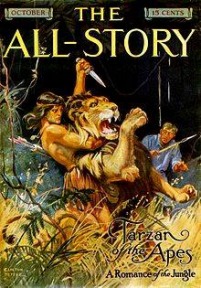
GOOD MORNING, MUR. APFEL
July 21, 1921: A. C. McClurg rejected
The
Oakdale Affair, despite the fact that it had been accepted and
previously published by Blue Book Magazine in March 1918 and also made
into a feature movie, alternately titled: "Bringing Up Baby" and "The Warning.”
The
film was an Oscar Apfel Production and released by World Film Corporation.
I have been unable to find even a video clip of the film. It starred Evelyn
Greeley, born in Austria as Evelyn Huber. Because of anti-German sentiment
during World War One, she falsely claimed to be the granddaughter of Horace
Greeley and to have been born in Lexington, Kentucky. This widely unknown
star of an Edgar Rice Burroughs film died in Florida in 1975. Oscar Apfel,
from Cleveland, directed 94 films and acted in 167.
“Good Morning, Mr. Apfel” is today’s drabble.
Oscar Apfel asked, “Miss Greeley, your English isn’t
very good for a relative of Horace Greeley.”
“It’s better than yours. This is a silent picture.
What does it matter?”
‘I like to know who I’m working with. Aren’t you a
Huber from Austria?”
“Your family was Armenian.”
“In America, we are all Americans.”
‘Mr. Apfel, you can’t have it both ways. I can’t be
descended from Horace Greeley and be from Austria. I can’t be both Austrian
and American. Make up your mind.""
Fair enough. You pays your money and you takes your
pick. Let’s see if you can act”
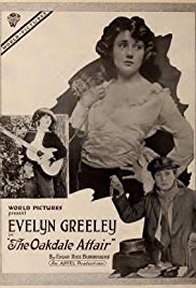
TO THE VICTOR
July 22, 1922: A. C. McClurg
published the first edition of “At
The Earth’s Core,” complete with a dust jacket and nine interior
sepia plates illustrated by J.
Allen St. John. The print run was 17,000 copies and the 277 page
book ran about 117,000 words.
“To the Victor” is the drabble for today.
Hooja, the sly one, attempted to make Dian, the Beautiful,
his mate. David Innes intervened and quickly dispatched Hooja.
Dian waited quietly. He said nothing. Finally, she
said, “Well?”
Confused, David said, “Well, you’re welcome.”
Dian stomped away. David asked her uncle. “What’s wrong?”
“When men fight for a woman, the victor either claims
her or releases her. You did neither. That makes her your slave.”
“I didn’t know. How do I fix it?”
“Don’t know, but I know she won’t make a good slave.
You’d best figure it out before she kills you.”
“Any advice.”
“Don’t go to sleep.”
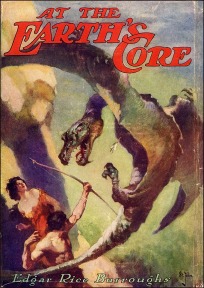
GENTLEMAN'S CHOICE
July 23, 1914: On this day in
Austria – Hungary presented Serbia with an ultimatum and only 48 hours
to respond, and Edgar Rice Burroughs began writing the sequel to “The
Cave Girl.” The first installment of “The
Cave Man” was originally published in All-Story Weekly on March
31, 1917. The issue contained 14 other stories, the authors and story titles
have long since been largely forgotten. The Fred
W. Small cover has always been one of my favorites. (On July 25,
Serbia complied with the ultimatum.)
The drabble for today is “Gentleman’s Choice.”
Thandar, Waldo Emerson Smith-Jones island name, went
to Nadara’s father to ask for her hand. The old man said, “You man enough
to take her, take her. It’s our way.”
Smith-Jones said, “A gentleman always asks the father.”
Chief Big Fist intruded and grabbed Nadara. Thandar
fought and killed the mighty warrior.
Nadara smiled. “Now you chief. Now we mate.”
“Not until we can have a proper ceremony. A gentleman
in my country follows the rules of decency and requires the proprieties
to be observed.”
“A woman could have four children waiting for a stupid
gentleman to follow stupid rules.”
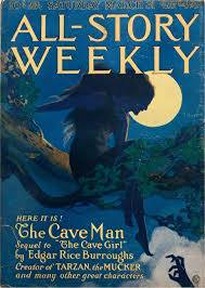
MAKE UP YOUR MIND
July 24, 1937: Edgar Rice Burroughs
began writing “Carson
of Venus,” the third book in his Venus series. I was never surprised
that Carson Napier was always in trouble on Amtor. After all, he did land
on the wrong planet. Carson disguises himself several times and uses several
names in the book. The novel is a strong and effective critique of Nazism.
I always wondered why it isn’t considered as important a piece of political
satire as “Animal Farm.” The attached illustration is of an Ace paperback
edition.
“Make Up Your Mind” is today’s drabble.
The guard said, “Who goes there?”
“I think I’m a farmer from Houtamia.”
“Houtamians have red hair.”
Carson realized that his hair was dyed brown. “Name’s
Homo Sapiens. I escaped the Zanis. They want to conquer all of Amtor.”
“We don’t like Zanis around here. What’s your business?”
"Uhh, I sell jewelry.”
“You got a license?”
“Uhh, no. Forget the jewels. I’m Prince Vodo of Vodaro.”
“Make up your mind. Did you say that your name is
Vad Varo?”
“No, that’s a different story.”
“Well, pick a name and stick to it. Can’t trust a
man with too many names.”
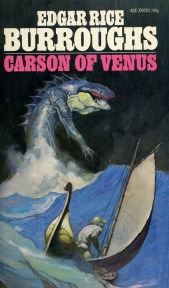
FROM THE PULPIT
July 25, 1949: On this day Time
Magazine published a promotional article on the upcoming Tarzan movie,
"Tarzan and the Slave
Girl." The article was headlined "Durable
Lianas." Liana is any species of various woody vines, especially
those found in tropical rain forests. Lianas are always rooted in the ground.
The writer of the article reported that Johnny Weissmuller
lost the gig because he was too fat and that Tarzan and Jane were never
married. Fortunately, an ERB fan saw the error and wrote a letter to Time
correcting it. I’m told, but haven’t verified that the letter was published
in a subsequent issue. (I’m not willing to subscribe to Times Online to
view the old issues and the July 25, 1949 issue with Harold Lloyd on the
cover sells for $40.00 and up on EBay.) The writer of the letter was Reverend
Henry Hardy Heins, author of "A Golden Anniversary of Edgar Rice
Burroughs."
“From the Pulpit” is the drabble for today.
T. S. Mathews, the managing editor of Time Magazine
called his cinema editor on the carpet. “It’s bad enough you called Weissmuller
fat, but I got a letter from some Lutheran Minister. Says you’re full of
poppycock. Tarzan and Jane were married. He quotes chapter and verse. You
got anything to contradict him?”
“No, I just heard it somewhere.”
Where, though the grapevine. If we can’t get something
that simple right, people won’t believe a damn thing we write.”
“I’ll check it out.”
“Don’t check anything. I’m going to run the letter
with an apology. If Weissmuller complains, you’re fired.”
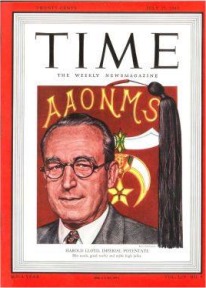
SITUATIONAL SKILL SET
July 26, 1938: On this day the Big
Little Book, "Tarzan's
Revenge," was copyrighted. The cover features Tarzan with a tiger
wearing an expression of extreme bewilderment on its face. The first printing
of the BLB had a circle on the cover that identified it as a Big Little
Book. The book follows the movie’s story line. "Tarzan's
Revenge," starred Glenn Morris and party girl, Eleanor Holm, a
pair of Olympic champions. Eleanor won the hundred meter backstroke in
1932. She qualified for the 1936 Olympics, but was removed from the team
for drunken behavior on the transatlantic voyage. Morris won the decathlon
in 1936. “Tarzan’s Revenge” appears to be the only Tarzan film with two
Olympic champions.
“Situational Skill Set” is today’s drabble.
Eleanor accompanied her parents to Africa in search
of specimens for American zoos, but their corrupt guide planned to sell
Eleanor to a sheikh, where she would become one of a hundred female slaves
in his harem.
Eleanor fled, but fell in a mud pit. Tarzan saved her.
A lioness attacked her. Tarzan saved her.
The evil guide captured her. Tarzan saved her.
The sheikh's tribesmen captured her. Tarzan saved her
again.
“Woman, have you no survival skills?
“I dance a mean Charleston, can drink a bottle of scotch
in two minutes, and I look great in a bathing suit.”
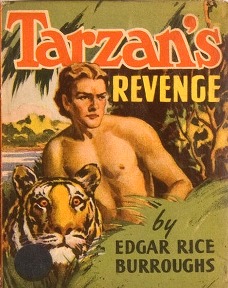
HAPPY BIRTHDAY JESSE MARSH
July 27, 1907: The prolific Jesse
Marsh, the first artist to produce original illustrations for Tarzan
comic books, was born. He passed away April 28, 1966, a year after
failing health made it necessary for him to stop illustrating Tarzan. He
produced an amazing body of work in addition to the Tarzan series: John
Carter, Gene Autry, Daniel Boone, Davy Crockett and even did the
first work on Brothers
of the Spear before Russ Manning took it over. Jesse’s Tarzan illustrations
were clean and simple, his jungles verdant and lush, and his women were
attractive and properly proportioned. He used a clean lined point of view
technique that never detracted from the story. His work appeared in 155
Tarzan comics including the Four Color Tarzan issues. That total doesn’t
include annuals or special editions.
“Happy Birthday, Jesse Marsh” is today’s drabble.
Jesse Marsh said, “I’ll draw Tarzan if you want. Who’s
going to write these comics?”
“Gaylord Dubois. You ever work with him.”
“Yes, he’s easy to work with. He meets deadlines and
gives clear direct instructions, but I’d rather draw Westerns. Any chance
I can continue with those.”
“Sure, this Tarzan thing won’t last forever. If you
can keep up the pace, you can pick up some other work along the way.”
“As long as I don’t have to draw cute talking bunnies,
mice or ducks, we’re good.”
“Don’t worry, I’m sure Dubois won’t write “Tarzan meets
Peter Cottontail.”
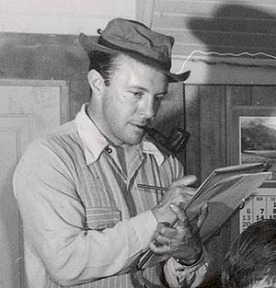
NEW SHERIFF IN TOWN
July 28, 1930: Edgar Rice Burroughs decided
that he was pleased with Miss
Adele Bischoff’s manuscript editing. She had been recommended to
him by Van Nuys High School principal, J. P. Inglis. Burroughs promptly
sent her Dancing Girl
of the Leper King and three installments of Tarzan
and the Leopard Men. ERB’s employed freelance editor Adele Bischoff
as he readied the first books of Edgar Rice Burroughs, Inc. for publication.
Irwin Porges, in Edgar Rice Burroughs: The Man Who Created Tarzan (1st
edition, 455-456, 758), presumes that this high school English teacher
from Van Nuys, California assisted with Tarzan the Invincible, and expressly
states that she edited “The Dancing Girl of the Leper King” (Jungle Girl)
and Tarzan and the Leopard Men. Although Bischoff may have corrected galley
proofs, she also addressed the actual manuscript for Leopard Men. ERB,
in a letter to Bischoff, complimented her “painstaking and intelligent
editing.”
Porges’ final reference to this editor-English teacher
is in regard to ERB’s submission to Bischoff of three chapters of Leopard
Men on October 2, 1931. Although Porges provided no documentation of additional
contact between the two, the fact that ERB began writing City of Gold just
50 days later on November 21 (completing it January 7, 1932) is circumstantial
evidence that Bischoff likely is responsible for the abnormalities in the
latter novel. Miss Bischoff was assigned to Van Nuys High School on September
11, 1922. The photo is of the high school in 1923. I would appreciate any
additional information about Adele Bischoff.
“New Sheriff in Town” is the drabble for today.
"Mr. Inglis, my name is Edgar Rice Burroughs."
“As in Tarzan Edgar Rice Burroughs?”
“Yes, guilty as charged.”
“Love your work. I’m a big fan. How can I help? You
don’t have children or grandchildren in school here, do you?”
“Nothing like that. I’m forming my own publishing company.
I need an editor and proofreader. I don’t want a person who’s afraid to
hurt my feelings. I want someone who’ll really edit my manuscripts before
I publish them."
“You want Adele Bischoff. She’d edit the Ten Commandments
down to four and give the writer a C for lack of brevity.”
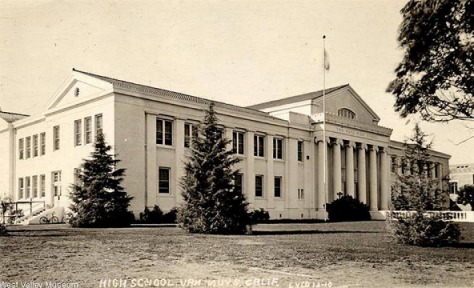
RIDE THE WILD MAHAR
July 29, 1971: The last original Tarzan
daily comic strip appeared. The Russ
Manning, “Tarzan
Returns to the Earth’s Core.” Not only was it the last daily Russ
Manning strip, but it was the last Tarzan daily strip. Tarzan was published
as a daily newspaper comic from January 7, 1929 until July 29, 1971. A
pretty good run. Here’s the last panel of the last Tarzan daily strip.
The second picture is of Dav-ani’s father. The man looks remarkably like
the artist, Russ Manning.
“Ride the Wild Mahar” is the drabble for today.
Tarzan boarded the 0-222, David Innes airship, and
returned to Pellucidar in search of Korak. His son, along with Dav-ani,
an attractive young girl, and others had been captured by Saggoths and
were being taken to Sari, where they would be fed to Mahars.
Once reunited, Tarzan and Korak, fought and defeated
the Mahars and their minions once more. Korak asked. “Tarzan, why don’t
we kill all these flying people eaters. Is it because you don’t want to
destroy a species, no matter how dangerous they are?”
“Not at all. Don’t tell your mother, but sometimes
they’re fun to ride.”

